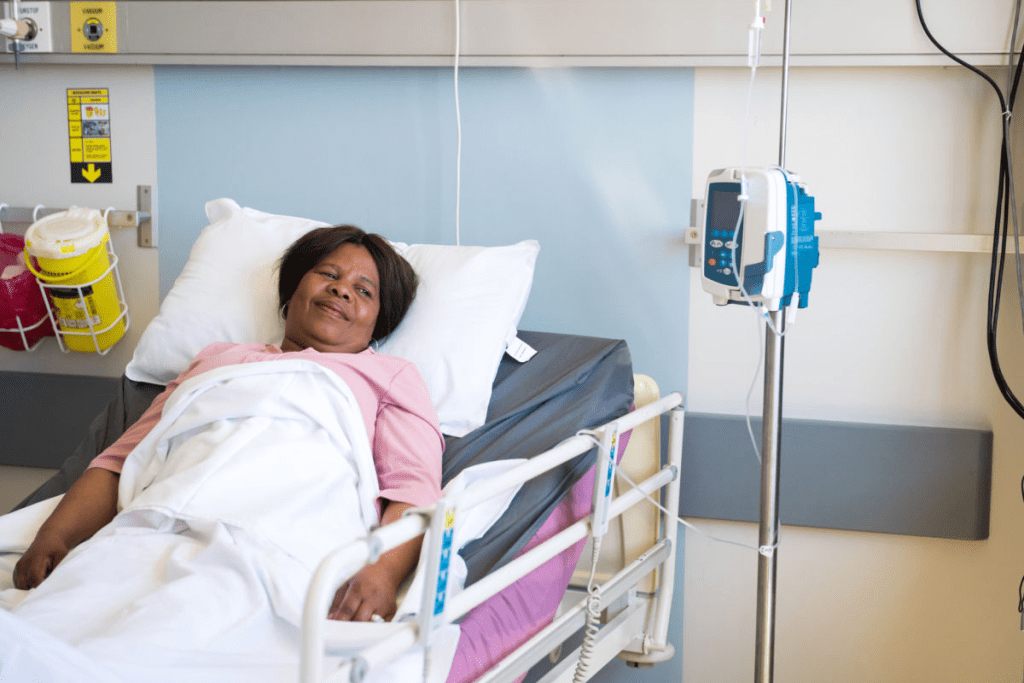Last Updated on November 26, 2025 by Bilal Hasdemir

Nearly 1 in 8 men will be diagnosed with best prostate cancer treatment at some point in their lives. It’s one of the most common cancers among men. Choosing the right treatment options can be tough. We’ll look at different ways to treat prostate cancer. We’ll talk about what makes a treatment successful and how patients can make informed choices. It’s important for patients to understand their treatment options. This helps them make the best choice for their situation.
Key Takeaways
- Prostate cancer is a common diagnosis among men worldwide.
- Multiple treatment options are available, each with its own benefits.
- The most successful treatment depends on the individual case.
- Patients should consider various factors when choosing a treatment.
- Informed decisions lead to better health outcomes.
Understanding Prostate Cancer: Types and Stages

It’s important to know about prostate cancer’s types and stages to find the best treatment. Prostate cancer is a complex disease needing a detailed approach for diagnosis and treatment.
Different Types of Prostate Cancer
The most common type of prostate cancer is adenocarcinoma, coming from glandular cells. Other rare types include small cell carcinoma, neuroendocrine tumors, and sarcomas. Each type affects treatment choices differently.
The TNM Staging System
The TNM staging system is a key tool for understanding prostate cancer. It looks at the tumor’s size and spread (T), nearby lymph nodes (N), and distant metastasis (M). This system helps in planning treatment.
- T (Tumor): Shows the tumor’s size and spread.
- N (Node): Checks if cancer has reached nearby lymph nodes.
- M (Metastasis): Finds if cancer has spread to distant areas.
Gleason Score and Risk Assessment
The Gleason score grades prostate cancer’s aggressiveness from biopsy samples. Scores range from 2 to 10, with higher scores meaning more aggressive cancer. The Gleason score, PSA level, and clinical stage help decide treatment.
Risk levels are:
- Low risk: PSA ≤ 10, Gleason score ≤ 6, and clinical stage ≤ T2a.
- Intermediate risk: PSA 10-20, Gleason score 7, or clinical stage T2b-T2c.
- High risk: PSA > 20, Gleason score 8-10, or clinical stage ≥ T3a.
Knowing the type, stage, and grade of prostate cancer helps doctors create a treatment plan tailored to each patient.
Factors That Determine the Best Prostate Cancer Treatment
Choosing the right treatment for prostate cancer is complex. It depends on many factors. Each one plays a big role in finding the best option.
Age and Overall Health
A patient’s age and health are key in picking a treatment. Older patients or those with health problems might need a gentler approach. This helps avoid serious side effects. We look at the patient’s health, including any other conditions they have. For example, someone with heart disease or diabetes might not be able to have certain treatments. These treatments could make their health worse.
Cancer Stage and Grade
The cancer’s stage and grade are very important. The stage tells us how far the cancer has spread. The grade shows how abnormal the cancer cells are.
- Localized Cancer: Cancer that is confined to the prostate gland.
- Locally Advanced Cancer: Cancer that has spread beyond the prostate but is within the pelvic region.
- Metastatic Cancer: Cancer that has spread to distant parts of the body.
PSA Levels and Doubling Time
PSA levels and doubling time are key in understanding the cancer’s aggressiveness. They help us see how fast the cancer is growing. If the PSA level goes up quickly, it might mean the cancer is aggressive. This could mean we need to treat it more aggressively.
Patient Preferences and Quality of Life Considerations

What the patient wants and how they want to live is also important. We talk to patients to understand what matters most to them. For instance, some might worry more about keeping their bladder control or sexual function. Others might focus on living longer.
Active Surveillance: When Watching and Waiting is Best
Understanding active surveillance is key for men looking at prostate cancer treatment options. It’s a strategy that closely watches the cancer without immediate treatment. The goal is to avoid or delay treatments and their side effects.
Candidates for Active Surveillance
Not all men with prostate cancer fit the bill for active surveillance. Those who might include:
- Men with low-risk prostate cancer, based on PSA levels, Gleason score, and clinical staging
- Those with a life expectancy that doesn’t need immediate treatment due to age or health issues
- Men who prefer to avoid or delay treatment side effects
We assess each patient to see if active surveillance is right for them.
Monitoring Protocols
Active surveillance requires a strict monitoring plan. This ensures any cancer changes are caught early. The plan includes:
- Regular PSA tests to watch prostate-specific antigen levels
- Periodic digital rectal exams (DRE) to check the prostate gland
- Repeated prostate biopsies to look for cancer progression signs
- Imaging studies, like MRI, in some cases to check the prostate and nearby tissues
These steps are vital for catching cancer progression signs early, allowing for timely action if needed.
Success Rates and Outcomes
The success of active surveillance is seen in avoiding or delaying treatment without harming long-term health. For men with low-risk prostate cancer, it’s a safe and effective choice.
Key outcomes include:
- High rates of cancer-specific survival
- Low rates of metastasis
- Avoidance or delay of treatment-related side effects
We keep tracking the results of patients on active surveillance. This helps us better understand its benefits and limits.
Surgical Options for Prostate Cancer
Prostate cancer surgery has changed a lot, giving patients many options. Surgery is often chosen for those with early prostate cancer. It aims to remove the tumor and possibly cure the disease.
Radical Prostatectomy Explained
Radical prostatectomy removes the prostate gland and nearby tissues. It’s done to cure prostate cancer by taking out the gland where the cancer is. Radical prostatectomy is for men with cancer that’s only in the prostate.
Open vs. Laparoscopic vs. Robotic Prostatectomy
There are different ways to do a radical prostatectomy. Open prostatectomy uses one big cut. Laparoscopic prostatectomy makes small cuts and uses a laparoscope. Robotic prostatectomy is a laparoscopic method that uses a robotic system. It helps the surgeon be more precise and flexible. Each method has its own benefits and risks. Robotic prostatectomy is less invasive. It might lead to less blood loss and faster recovery than open surgery.
Recovery and Side Effects
Recovery from prostate surgery depends on the method and the patient’s health. Common side effects are urinary incontinence and erectile dysfunction. But, many men see these symptoms improve over time. Talking to your doctor about what to expect is important. This helps you know what to look out for after surgery.
Success Rates and Long-term Outcomes
The success of prostate cancer surgery is measured by how often the cancer comes back and how long patients live. Radical prostatectomy is very effective for early prostate cancer. It has a high chance of curing the disease. Long-term results depend on the cancer’s stage and grade, the patient’s health, and the surgery type. Regular check-ups are key to catch any signs of cancer coming back.
Radiation Therapy Approaches
Prostate cancer treatment often includes radiation therapy. There are different types, each with its own benefits and things to consider. We’ll look at the various ways radiation therapy is used to treat prostate cancer. This will help patients understand their options.
External Beam Radiation Therapy (EBRT)
External Beam Radiation Therapy (EBRT) is a common treatment for prostate cancer. A machine outside the body sends radiation beams to the prostate gland. This method targets cancer cells well while protecting nearby tissues. EBRT is given over several weeks, with treatments daily, Monday through Friday. The treatment’s dose and length depend on the cancer’s stage, grade, and the patient’s health.
Intensity-Modulated Radiation Therapy (IMRT)
Intensity-Modulated Radiation Therapy (IMRT) is an advanced version of EBRT. It allows for even more precise radiation delivery. IMRT adjusts the radiation beam’s intensity to fit the tumor’s shape, reducing damage to healthy tissues. IMRT is great for prostate cancer because it delivers high doses of radiation to the tumor. This can improve outcomes and reduce side effects.
Brachytherapy (Seed Implantation)
Brachytherapy, or seed implantation, places small radioactive seeds in the prostate gland. This method gives a high dose of radiation directly to the tumor, protecting healthy tissues. Brachytherapy can be used alone or with EBRT, based on the cancer’s stage and risk factors. It’s effective for localized prostate cancer and has a shorter treatment time than EBRT.
Proton Therapy: Benefits and Limitations
Proton therapy uses protons instead of X-rays to kill cancer cells. It delivers radiation with great precision, potentially reducing side effects by protecting healthy tissues. Proton therapy is promising but less available than other radiation therapies. Its benefits over other treatments are being studied. Yet, it’s a valuable option for some patients, mainly those with localized disease or specific anatomical needs.
Hormone Therapy for Prostate Cancer
Hormone therapy plays a key role in treating prostate cancer. It involves different methods to lower hormone levels or block their effects on cancer cells. This treatment, also known as androgen deprivation therapy (ADT), aims to reduce male hormones in the body. It stops these hormones from affecting prostate cancer cells.
Androgen Deprivation Therapy (ADT) Explained
ADT is a main treatment for advanced prostate cancer. ADT reduces androgen production or blocks their effect on cancer cells. It can be done through surgery or medicine. Surgical castration removes the testes, where androgens are made. Medical castration uses drugs to achieve the same effect. Medical castration includes LHRH agonists and antagonists. LHRH agonists first increase testosterone levels but then lower them. LHRH antagonists immediately lower testosterone levels without a surge.
Types of Hormone Treatments
There are many hormone treatments for prostate cancer. LHRH agonists like leuprolide and goserelin are common. They first raise testosterone levels but then lower them. LHRH antagonists like degarelix immediately lower testosterone levels. Anti-androgens block androgens’ effect on cancer cells. Drugs like bicalutamide and flutamide are examples. Sometimes, these treatments are combined, known as combined androgen blockade (CAB).
Side Effects and Management
Hormone therapy for prostate cancer can cause side effects. These include hot flashes, fatigue, weight gain, and loss of sexual desire. Managing these side effects is key to keeping patients’ quality of life. Managing side effects involves lifestyle changes and medications. For example, bisphosphonates prevent bone loss from ADT.
Effectiveness as Primary and Adjuvant Treatment
Hormone therapy is used as primary treatment for advanced prostate cancer. It’s also used as adjuvant therapy with other treatments like radiation or surgery. This improves treatment outcomes. Hormone therapy is effective, slowing disease progression for many patients. But, some may develop castration-resistant prostate cancer (CRPC) over time.
Cryotherapy and Focal Therapies
Men with prostate cancer have new hope with cryotherapy and focal therapies. These methods aim to kill cancer cells without harming healthy tissue. This can lead to fewer side effects.
How Cryotherapy Works
Cryotherapy freezes prostate cancer cells to death. It’s done under general anesthesia or sedation. Doctors use ultrasound to guide probes to the tumor. Once in place, the probes freeze the cancer cells. Cryotherapy’s advantages include being less invasive and having quicker recovery times. It may also help keep urinary and sexual functions intact. But, it’s important to talk to a doctor about the risks and benefits.
HIFU and Other Focal Treatments
High-Intensity Focused Ultrasound (HIFU) is another focal therapy for prostate cancer. It uses ultrasound waves to heat and kill cancer cells. This method targets the tumor precisely, leaving healthy tissue untouched. Other focal treatments include laser ablation and irreversible electroporation (IRE). Each works differently. Focal therapies like HIFU are appealing because they treat cancer effectively while reducing side effects. The right treatment depends on the cancer’s stage, grade, and the patient’s health and preferences.
Ideal Candidates and Success Rates
Men with localized prostate cancer, and those with low to intermediate risk, are good candidates. The success of these treatments is measured by cancer control, survival rates, and quality of life. Research shows cryotherapy and HIFU are effective in controlling cancer and reducing side effects. But, more long-term data is needed. Ongoing research aims to improve patient selection and treatment protocols. In conclusion, cryotherapy and focal therapies are big steps forward in prostate cancer treatment. They offer hope for men looking for effective, less invasive options. Patients need to discuss their options with their healthcare team to find the best fit.
Immunotherapy Approaches for Prostate Cancer
Immunotherapy is a new way to fight prostate cancer. It uses the body’s immune system to attack the disease. This method is getting a lot of attention because it offers personalized treatment.
Sipuleucel-T (Provenge) and How It Works
Sipuleucel-T, also known as Provenge, is a treatment for advanced prostate cancer. It helps the immune system find and fight prostate cancer cells. First, a patient’s dendritic cells are taken out. Then, these cells are treated with a special protein in a lab. This protein helps the cells recognize prostate cancer cells. After treatment, the cells are put back into the patient. They help the immune system fight cancer. “Sipuleucel-T has been a big step forward in treating prostate cancer,” says, a leading oncologist. “It uses the immune system to help patients with advanced disease.”
Emerging Immunotherapy Options
New treatments are being studied for prostate cancer. These include checkpoint inhibitors, cancer vaccines, and adoptive T-cell therapies. Checkpoint inhibitors help the immune system attack cancer cells better.
- Checkpoint inhibitors: Drugs that block proteins made by T cells and cancer cells, making the immune response stronger against cancer.
- Cancer vaccines: Therapies that help the immune system recognize and attack cancer cells, like Sipuleucel-T.
- Adoptive T-cell therapies: Treatments that take T cells, modify them to better recognize cancer, and then put them back into the patient.
Patient Selection and Outcomes
Immunotherapy works differently for everyone. The stage of cancer, overall health, and genetic markers can affect how well it works. Choosing the right patients is key, and research is ongoing to find better ways to do this.
Key considerations for patient selection include:
- The stage and grade of prostate cancer.
- The patient’s overall health and performance status.
- Previous treatments and their outcomes.
By carefully choosing patients and tailoring treatments, doctors can make immunotherapy more effective in fighting prostate cancer.
Chemotherapy for Advanced Prostate Cancer
Men with advanced prostate cancer often use chemotherapy as part of their treatment. This is because advanced cancer needs a strong treatment plan. Chemotherapy is a key part of this plan.
When Chemotherapy is Recommended
Chemotherapy is usually suggested when cancer has spread to other parts of the body. This includes the bones, lymph nodes, or other organs. Doctors consider many factors before starting chemotherapy.
- Cancer that has metastasized to distant sites
- Cancer that is not responding to hormone therapy
- Significant symptoms or rapid disease progression
Common Chemotherapy Drugs
Several drugs are used to treat advanced prostate cancer. The most common include:
- Docetaxel: Often used as a first-line treatment, it has been shown to improve survival.
- Cabazitaxel: Used for cancer that has progressed after docetaxel treatment.
- Mitoxantrone: Sometimes used in combination with other treatments.
These drugs target and kill fast-growing cancer cells.
Managing Side Effects
Chemotherapy can cause side effects, from mild to severe. Common side effects include:
- Fatigue
- Nausea and vomiting
- Hair loss
- Increased risk of infections
It’s important to manage these side effects to keep the patient’s quality of life good. This can involve medications for nausea, rest for fatigue, and other supportive care.
Effectiveness in Metastatic Disease
Chemotherapy is effective in treating metastatic prostate cancer. It improves survival and quality of life for many patients. The choice of chemotherapy depends on several factors.
Studies show that chemotherapy can:
- Reduce tumor size and slow disease progression
- Alleviate symptoms such as pain
- Improve overall survival in some cases
Targeted Therapy and Precision Medicine
Targeted therapy and precision medicine are changing how we treat prostate cancer. They offer more effective and personalized treatments. This method focuses on the genetic and molecular traits of each patient’s cancer. It tailors treatments to match each patient’s needs.
PARP Inhibitors
PARP inhibitors are a big step forward in treating prostate cancer. PARP is a protein that helps fix DNA damage. In some patients, like those with BRCA1 and BRCA2 mutations, PARP inhibitors work well. They take advantage of cancer cells’ trouble with DNA repair.
Clinical trials show PARP inhibitors are effective for certain prostate cancer patients. For example, olaparib and rucaparib are approved or in review for prostate cancer treatment.
Genetic Testing and Personalized Treatment
Genetic testing is key in managing prostate cancer. It helps find the right targeted therapies for each patient. This approach boosts treatment success and reduces side effects.
Genetic testing can spot mutations that PARP inhibitors can target. It also helps predict the risk of cancer coming back. This guides decisions on whether to use additional treatments.
Future Directions in Targeted Therapy
The field of targeted therapy for prostate cancer is growing fast. New agents and strategies are being explored. Researchers aim to find new targets and ways to beat resistance to current treatments.
One area of research is therapies targeting the androgen receptor pathway. This is key in prostate cancer growth. Other promising areas include combining immunotherapy with targeted therapies and using biomarkers to predict treatment success.
Therapy Type | Mechanism | Potential Benefits |
| PARP Inhibitors | Inhibit DNA repair in cancer cells with specific mutations | Effective in patients with BRCA1/2 mutations, improved progression-free survival |
| Androgen Receptor Targeted Therapies | Target the androgen receptor pathway | Potential to overcome resistance to hormonal therapies, improved overall survival |
| Immunotherapy Combinations | Combine targeted therapies with immunotherapies | Enhanced anti-tumor immune response, potentially durable responses |
Best Prostate Cancer Treatment Options by Stage
Different stages of prostate cancer need different treatments. Staging is key in planning treatment. We’ll look at the best treatments for each stage, ensuring patients get the right care.
Early-Stage (Localized) Prostate Cancer
Early-stage prostate cancer focuses on removing the cancer while keeping quality of life. Active surveillance is common, using PSA tests and biopsies. For quicker action, radical prostatectomy or radiation therapy might be chosen. Radical prostatectomy removes the prostate gland, often with robotic help. Radiation therapy, like EBRT and brachytherapy, is also effective. The choice depends on health, cancer details, and personal wishes.
Locally Advanced Prostate Cancer
Locally advanced cancer has grown but hasn’t spread far. Treatment often combines therapies. Radiation therapy is common, sometimes with hormone therapy to lower testosterone. Hormone therapy, or ADT, can lower testosterone levels. This can be through medication or surgery. Radiation and hormone therapy together can control the cancer well.
Metastatic Prostate Cancer
Metastatic cancer has spread to other parts of the body. Treatment aims to control the cancer and improve quality of life. Hormone therapy is key, aiming to lower testosterone. Other treatments include chemotherapy, immunotherapy, and targeted therapy. Chemotherapy kills cancer cells. Immunotherapy boosts the immune system. Targeted therapy targets cancer cells.
Recurrent Prostate Cancer
Recurrent cancer has come back after treatment. Treatment depends on the first treatment and the cancer’s location. Salvage therapy might be radiation or surgery, depending on the first treatment. For recurrence, hormone therapy and other treatments are used. Treatment is tailored to the patient’s health, previous treatments, and cancer details.
Comparing Success Rates Across Treatments
Looking at how well different prostate cancer treatments work helps patients make better choices. Success is measured in many ways, like how long patients live, how well they feel, and if the cancer comes back.
Defining “Success” in Prostate Cancer Treatment
Success in treating prostate cancer means more than just getting rid of the cancer. It also means keeping the patient’s quality of life good and minimizing side effects. We look at survival rates, how often the cancer comes back, and what patients say about their experience.
“The goal of prostate cancer treatment is not just to extend life, but to preserve its quality.” –
A renowned oncologist
5-Year and 10-Year Survival Rates
Survival rates are key to knowing if a treatment works. For prostate cancer, these rates change based on when the cancer is found and the treatment used.
| Treatment | 5-Year Survival Rate | 10-Year Survival Rate |
| Radical Prostatectomy | 95% | 90% |
| External Beam Radiation Therapy (EBRT) | 92% | 85% |
| Brachytherapy | 93% | 88% |
Quality of Life Outcomes
How well patients feel after treatment is very important. Different treatments affect how patients pee, have sex, and move their bowels differently. For example, surgery can cause problems with peeing and sex, but how bad it is can vary. Radiation can also cause issues like needing to pee a lot and bowel problems.
Biochemical Recurrence Rates
When the PSA level goes up after treatment, it means the cancer might be back. How often this happens depends on the treatment and the cancer’s stage and grade at the start.
Table: Biochemical Recurrence Rates by Treatment
| Treatment | Biochemical Recurrence Rate |
| Radical Prostatectomy | 20-30% |
| External Beam Radiation Therapy (EBRT) | 30-40% |
| Brachytherapy | 15-25% |
In summary, comparing prostate cancer treatments requires looking at many factors. By considering survival, quality of life, and how often the cancer comes back, patients and doctors can choose the best treatment.
Managing Treatment Side Effects
Prostate cancer treatment can come with side effects. But knowing how to handle them can really help. These treatments are good at fighting cancer, but they can also cause problems that affect your daily life. It’s important to manage these side effects to keep your quality of life high.
Sexual Dysfunction
Sexual problems are common after prostate cancer treatment. This can include trouble getting an erection or feeling less interested in sex. There are treatments available, like medicines and devices to help with erections. Counseling and support groups can also offer emotional support and advice.
Urinary Incontinence
Urinary incontinence is another possible side effect, often after surgery. Doing Kegel exercises can help strengthen the muscles that control urination. Sometimes, medicines or surgery may be needed to manage incontinence well.
Bowel Problems
Bowel issues, like diarrhea or constipation, can happen, mainly after radiation therapy. Eating foods high in fiber or avoiding certain foods might help. Medicines can also be used to treat these problems.
Fatigue and Other Systemic Effects
Fatigue is a common side effect of many prostate cancer treatments. Eating well, drinking plenty of water, and doing gentle exercise can help fight fatigue. Stress management through relaxation techniques or counseling can also be helpful.
| Side Effect | Management Strategies |
| Sexual Dysfunction | Medications, vacuum devices, penile implants, counseling |
| Urinary Incontinence | Kegel exercises, medications, surgical interventions |
| Bowel Problems | Dietary adjustments, medications |
| Fatigue | Balanced diet, hydration, exercise, stress management |
Emerging and Experimental Treatments
Prostate cancer research is moving forward fast. New treatments are coming up to help patients more. These new therapies give hope for better disease management, even for those with tough cases.
PSMA-Targeted Therapies
PSMA-targeted therapies are a big hope for prostate cancer treatment. They focus on the PSMA protein found on prostate cancer cells. This protein is often more on these cells than on healthy ones.
Key Benefits:
- They are very specific to prostate cancer cells, which means less harm to healthy tissues.
- They might work better for advanced prostate cancer.
- Researchers are looking into combining these therapies to make them even better.
New Hormonal Agents
New hormonal agents aim to stop prostate cancer cells from growing. They work by blocking the hormonal pathways that help cancer grow.
| Therapy | Mechanism of Action | Potential Benefits |
| Abiraterone | Inhibits CYP17, reducing androgen production | Improved survival in castration-resistant prostate cancer |
| Enzalutamide | Blocks androgen receptors, inhibiting tumor growth | Delayed disease progression, improved quality of life |
Clinical Trials Worth Considering
Clinical trials are key in finding new treatments for prostate cancer. Patients should talk to their doctors about the good and bad of joining trials.
Types of Clinical Trials:
- Phase I: Safety and dosing studies
- Phase II: Efficacy and side effect studies
- Phase III: Comparative studies against standard treatments
Joining clinical trials can give patients access to new treatments. This helps in finding better ways to fight prostate cancer.
Conclusion:
Prostate cancer treatment has changed a lot, with many options for each person. We’ve looked at different types of prostate cancer and what makes a treatment the best. We’ve also talked about surgery, radiation, hormone therapy, and new treatments. Choosing the right prostate cancer treatment is important. It depends on your age, health, cancer stage, and what you prefer. Talking to a doctor helps you make a choice that’s right for you. The best treatments are those made just for you. Using the latest medical tech and focusing on you can make a big difference. This way, we can help improve life for those with prostate cancer.
FAQ
What are the most common treatments for prostate cancer?
Common treatments for prostate cancer include surgery and radiation therapy. Hormone therapy and chemotherapy are also used. Active surveillance is an option for some.
How is the stage of prostate cancer determined?
The stage of prostate cancer is found using the TNM system. It looks at the tumor size, if it has spread to lymph nodes, and if it has gone to other parts of the body.
What is the Gleason score, and why is it important?
The Gleason score shows how aggressive prostate cancer is. It’s based on the tumor’s look under a microscope. It helps doctors decide on treatment.
What factors influence the choice of prostate cancer treatment?
Many things affect treatment choices. These include the patient’s age, health, and cancer details. PSA levels and personal preferences also play a big role.
What is active surveillance, and who is a suitable candidate?
Active surveillance is for low-risk prostate cancer. It means watching the cancer closely with tests and exams. It’s for those with low-risk cancer and a long life expectancy.
What are the different surgical options for prostate cancer?
Surgical options include open, laparoscopic, and robotic radical prostatectomy. The choice depends on the surgeon, the patient’s health, and the cancer’s details.
How does radiation therapy work for prostate cancer?
Radiation therapy kills cancer cells with high-energy rays. It can be given from outside the body (EBRT, IMRT) or inside (brachytherapy). The choice depends on the cancer and the patient’s health.
What is hormone therapy for prostate cancer, and how does it work?
Hormone therapy lowers male hormones that help cancer grow. It can be used alone or with other treatments.
What are the side effects of prostate cancer treatments?
Side effects vary by treatment. They can include sexual problems, urinary issues, bowel problems, and fatigue. Managing these side effects is key in prostate cancer care.
What is the success rate of different prostate cancer treatments?
Success rates depend on the treatment, cancer stage, and patient factors. Early-stage cancer often has a high cure rate. Advanced cancer focuses on symptom control and survival.
Are there emerging treatments for prostate cancer?
Yes, new treatments include PSMA-targeted therapies and immunotherapies like Sipuleucel-T (Provenge). Clinical trials are testing their safety and effectiveness.
How is the effectiveness of prostate cancer treatment measured?
Effectiveness is measured by survival rates, quality of life, and PSA levels. These help compare different treatments.
What is targeted therapy in prostate cancer?
Targeted therapy uses drugs that target cancer cells or genes. PARP inhibitors are used in prostate cancer, mainly for patients with certain genetic mutations.
Can prostate cancer be cured?
Prostate cancer can be cured, mostly if caught early. Treatments like surgery and radiation can be curative. Cure chances depend on the cancer’s stage, grade, and the patient’s health.
References
- European Association of Urology. (2025). Prostate Cancer Guidelines. https://uroweb.org/guidelines/prostate-cancer






